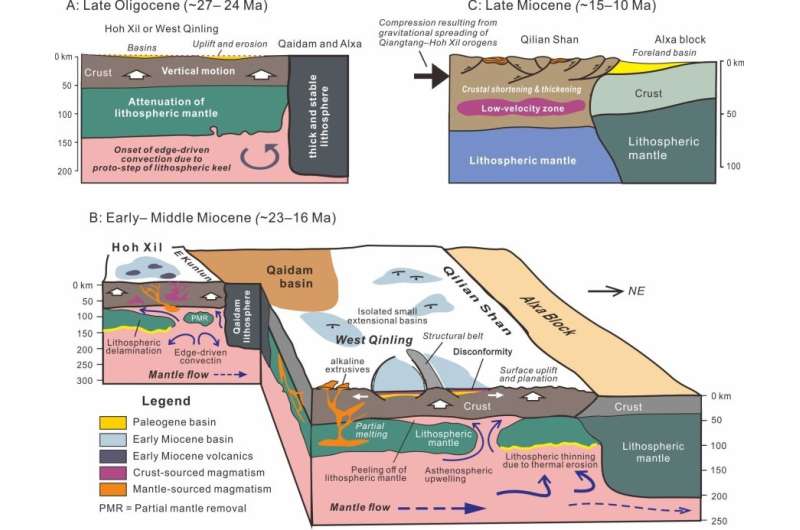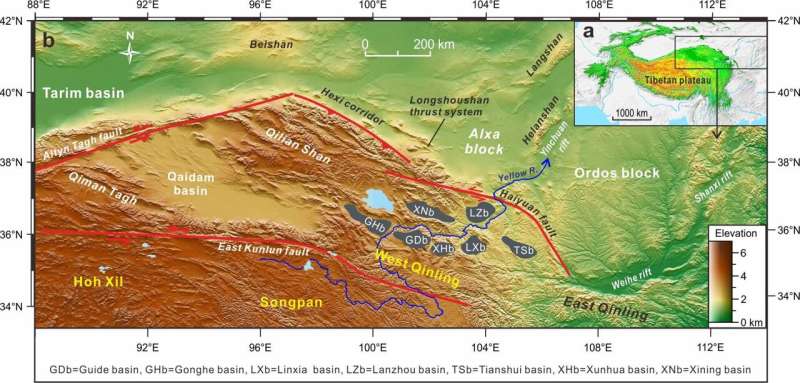Revisiting the mechanisms of mid-Tertiary uplift of the NE Tibetan plateau
A joint research team led by Dr. Wei Hong-Hong of the Institute of the Tibetan plateau at the Chinese Academy of Science has just published a study on mechanisms for mid-Tertiary uplifting of the NE Tibetan plateau in National Science Review.
A number of mechanisms have been advanced to account for creation of present-day topography of northeast Tibet, which manifests itself as a mosaic comprising plateaus, mountains and various-scale basins, such as the Hoh Xil plateau, Qaidam basin, Qilian Mountains, and many intermontane basins. Most of previous work ascribed topographic development of NE Tibet to crustal contraction. It, however, remains perplexing how the crust deformed throughout the Cenozoic.
Based on a synthesis of available geological and geophysical data and geologic observations, it is confirmed that the Hoh Xil and West Qinling had experienced surface uplift and broad planation since ~27 Ma. A marked stratigraphic break or unconformity, which separates Paleogene and Neogene strata, registered the uplifting event. Surface uplift was previously attributed to crustal contraction in mid-Tertiary timespan.
This study, however, reveals that strata below and above the unconformity are basically parallel in the West Qinling, thereby negating the postulation of pre-Neogene crustal contraction in that region. Also interesting is Paleogene–Neogene uninterrupted successions in the Qaidam basin, indicative of persistent subsidence and sedimentation in mid-Tertiary timespan. Obviously, differential crustal vertical motion happened in different areas of NE Tibet.

Vigorous volcanic eruption took place in the Miocene, with magma being sourced from the middle–lower crust and mantle. Volcanism occurred merely in the Hoh Xil and West Qinling, whereas the Qaidam basin is devoid of volcanic rocks. Various models are suggested to explain generation of magma of differing types, but existing explanations can hardly reconcile coeval occurrences of diverse tectonic processes.
Coincidence of crustal vertical motion and volcanic eruption in space and time implicates that the two processes should have been governed by same mechanism. This study proposes that small-scale edge-driven mantle convection might have been operating at the transition from orogenic and cratonic domains. The convection is generated due to resistance to northward asthenospheric flow by thicker cratonic lithosphere. This mechanism provides satisfactory explanations for some prominent geologic phenomena.
Edge-driven convection led to upwelling of asthenospheric hot materials that not only vertically raised the crust but also triggered magmatism in the lithosphere of the Hoh Xil and West Qinling orogenic regions. The Qaidam basin possesses thicker cratonic lithosphere and therefore avoids convectional effect.
Tectonic settings changed dramatically about 15 Ma when crustal shortening and thickening dominated the NE Tibetan plateau, as manifested by folding and faulting of Tertiary strata in the Qaidam basin and rapid rising of surrounding mountains. Gravitational collapse and spreading of Tibetan plateau interior is likely responsible for horizontal tectonic push that resulted in upper-crustal contraction of peripheral areas in late Cenozoic time.
More information:
Hong-Hong Wei et al, Revisiting the mechanisms of mid-Tertiary uplift of the NE Tibetan plateau, National Science Review (2023). DOI: 10.1093/nsr/nwad008
Citation:
Revisiting the mechanisms of mid-Tertiary uplift of the NE Tibetan plateau (2023, March 2)
retrieved 2 March 2023
from https://phys.org/news/2023-03-revisiting-mechanisms-mid-tertiary-uplift-ne.html
This document is subject to copyright. Apart from any fair dealing for the purpose of private study or research, no
part may be reproduced without the written permission. The content is provided for information purposes only.

A joint research team led by Dr. Wei Hong-Hong of the Institute of the Tibetan plateau at the Chinese Academy of Science has just published a study on mechanisms for mid-Tertiary uplifting of the NE Tibetan plateau in National Science Review.
A number of mechanisms have been advanced to account for creation of present-day topography of northeast Tibet, which manifests itself as a mosaic comprising plateaus, mountains and various-scale basins, such as the Hoh Xil plateau, Qaidam basin, Qilian Mountains, and many intermontane basins. Most of previous work ascribed topographic development of NE Tibet to crustal contraction. It, however, remains perplexing how the crust deformed throughout the Cenozoic.
Based on a synthesis of available geological and geophysical data and geologic observations, it is confirmed that the Hoh Xil and West Qinling had experienced surface uplift and broad planation since ~27 Ma. A marked stratigraphic break or unconformity, which separates Paleogene and Neogene strata, registered the uplifting event. Surface uplift was previously attributed to crustal contraction in mid-Tertiary timespan.
This study, however, reveals that strata below and above the unconformity are basically parallel in the West Qinling, thereby negating the postulation of pre-Neogene crustal contraction in that region. Also interesting is Paleogene–Neogene uninterrupted successions in the Qaidam basin, indicative of persistent subsidence and sedimentation in mid-Tertiary timespan. Obviously, differential crustal vertical motion happened in different areas of NE Tibet.

Vigorous volcanic eruption took place in the Miocene, with magma being sourced from the middle–lower crust and mantle. Volcanism occurred merely in the Hoh Xil and West Qinling, whereas the Qaidam basin is devoid of volcanic rocks. Various models are suggested to explain generation of magma of differing types, but existing explanations can hardly reconcile coeval occurrences of diverse tectonic processes.
Coincidence of crustal vertical motion and volcanic eruption in space and time implicates that the two processes should have been governed by same mechanism. This study proposes that small-scale edge-driven mantle convection might have been operating at the transition from orogenic and cratonic domains. The convection is generated due to resistance to northward asthenospheric flow by thicker cratonic lithosphere. This mechanism provides satisfactory explanations for some prominent geologic phenomena.
Edge-driven convection led to upwelling of asthenospheric hot materials that not only vertically raised the crust but also triggered magmatism in the lithosphere of the Hoh Xil and West Qinling orogenic regions. The Qaidam basin possesses thicker cratonic lithosphere and therefore avoids convectional effect.
Tectonic settings changed dramatically about 15 Ma when crustal shortening and thickening dominated the NE Tibetan plateau, as manifested by folding and faulting of Tertiary strata in the Qaidam basin and rapid rising of surrounding mountains. Gravitational collapse and spreading of Tibetan plateau interior is likely responsible for horizontal tectonic push that resulted in upper-crustal contraction of peripheral areas in late Cenozoic time.
More information:
Hong-Hong Wei et al, Revisiting the mechanisms of mid-Tertiary uplift of the NE Tibetan plateau, National Science Review (2023). DOI: 10.1093/nsr/nwad008
Citation:
Revisiting the mechanisms of mid-Tertiary uplift of the NE Tibetan plateau (2023, March 2)
retrieved 2 March 2023
from https://phys.org/news/2023-03-revisiting-mechanisms-mid-tertiary-uplift-ne.html
This document is subject to copyright. Apart from any fair dealing for the purpose of private study or research, no
part may be reproduced without the written permission. The content is provided for information purposes only.
